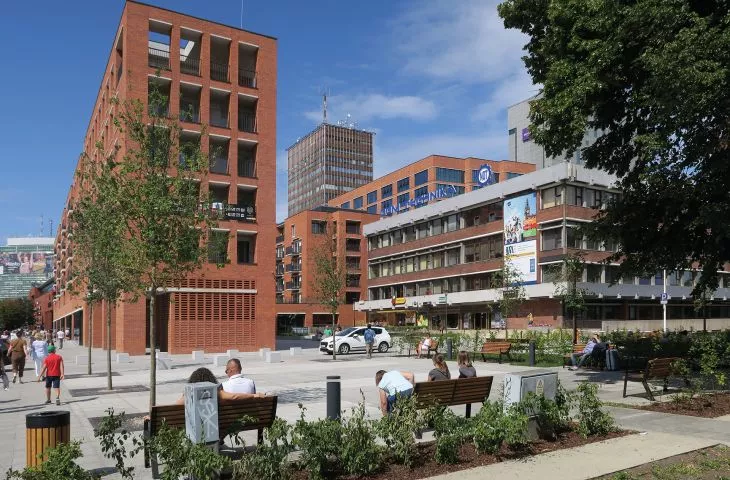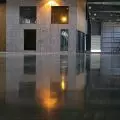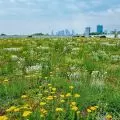Blockbusters
- Zaspa, with its hexagonal arrangement of blocks and one of the largest collections of murals in Europe, and Przymorze, with its eight-hundred-meter-high wavemill, are still popular and desirable places to live, densified by numerous new developments.
Tourists
- once mainly from Germany, today largely from Scandinavia. Thanks to them, the gastronomic season has extended considerably and includes winter - Gdansk restaurateurs say that tourists from the North don't mind the cold outside. This means that Downtown, until recently active only in the summer months, especially during the Dominican Fair, is bustling all year round.
Pomeranian Metropolitan Railway
- A new rail line that provides efficient transportation service to outlying neighborhoods and an additional connection between Gdansk and Gdynia. Around the distinctive red stops with facades perforated in thematic graphics, new housing developments are sprouting up in no time.
Office market
- For years Gdansk lagged behind Warsaw, Krakow or Wroclaw in terms of attractive jobs and high-end office space that could attract investors and new residents. Suddenly it has flourished. The largest concentration of offices is in Przymorze (Alchemia and Olivia Business Center), but Aiport City in the airport area is taking off.
The airport
- flight connections initially served mainly Scandinavia and Germany, but the network has recently expanded to include Ukraine and tourist destinations in the south, among others. Gradually expanded, the airport now serves about five million passengers a year, and with the realization of the PKM, a high-speed rail connection to Wrzeszcz and Downtown was provided.
European Solidarity Center
photo. © Monika Arczynska
European Solidarity Center
- the first large-scale cubature project on the post-shipyard grounds (the Fort project), housing, among other things, an exhibition on Solidarity, a library, conference rooms and the headquarters of numerous NGOs. The corten facades, to which it owed the nickname "rusty", made some people feel the need to paint it ("so new, and already rusty").
World War II Museum
- The realization of the winning competition design by Tri-City's Studio Kwadrat. One of Gdansk's biggest tourist attractions, the center of the political conflict between the central and local governments, and architecturally another variation on the theme of Gdansk's façade red after the ECS.
Shakespeare Theater
- A critically acclaimed, not necessarily by locals, realization of Renato Rizzi's design. It is sometimes referred to as a "sarcophagus" because of its black brick facades and simple form. The opening roof allows open-air performances; the theater and concert offerings are extensive, with the summer Shakespeare Festival, for example, taking place here.
Shakespeare Theater
photo. © Monika Arczynska
Beaches
- The most popular are Jelitkowo, Brzeźno and Stogi, while in summer it's worth going to the wide beaches of Sobieszewska Island to escape the crowds of tourists. Every year not only the cleanliness of the water in the Bay improves, but also the beach infrastructure - sanitary facilities, changing rooms and food and beverage outlets.
Garrison
- A housing estate in Wrzeszcz on the site of former barracks, today one of the most comfortable places to live, a cultural and gastronomic hub with Art of Choice (bookstore, café and design store) and the Old Manezh (venue for concerts and other cultural events). Although not all of the estate's buildings are architectural gems, the space between them is exemplary.
The landscape resolution
- has been in effect for almost two years, gradually clearing the city of advertising chaos and banning the fencing of new housing estates. The effects are already visible in the city's space, and by the beginning of April 2020, after a transitional period, all unregulated ads will have to disappear.
Planning
- Most of the city's area is covered by local plans (Gdańsk has the highest ratio among large Polish cities), and the city's planning unit, the Gdańsk Development Bureau, is also involved in the development of such strategic documents as the Gdańsk Urban Street Standard and the High-rise Object Location Study.
We walk
- usually along the seashore (actually, the Gulf of Gdansk) or the coastal strip, including in Reagan Park or along the moraine hills. Also along Olszynka, a district with an idyllic, even rural character, or the bastions of the Lower City.
We party
- in the summer season, obligatorily in the Shipyard, where the nightlife of Gdansk is concentrated: primarily on Elektryków Street and in the 100cznia bar built from containers. We agree - if in the center, then obligatorily "under LOT", that is, the former furniture pavilion and later headquarters of LOT Polish Airlines. For a good twenty years there has been a discussion about whether to protect the LOT as an example of post-war modernism, to rebuild the Danziger Hof hotel, which stood there before the war, or to realize a building that is contemporary in form. And although two years ago an architectural competition resulted in a concept for a glass building, we still meet under the same LOT.
We eat
- if vegan, on Wajdeloty Street in Lower Wrzeszcz, where a number of new establishments have popped up after the street was rebuilt and traffic slowed down on the first floor. There is also a sizable concentration of restaurants in Wrzeszcz Garrison, in Oliwa and, of course, in Downtown. Two food hall-type places have also recently opened - Słony Spichlerz on Wyspa Spichlerz and Stacja in the Metropolia shopping center.
Monika ARCZYŃSKA
Photo: the author



































